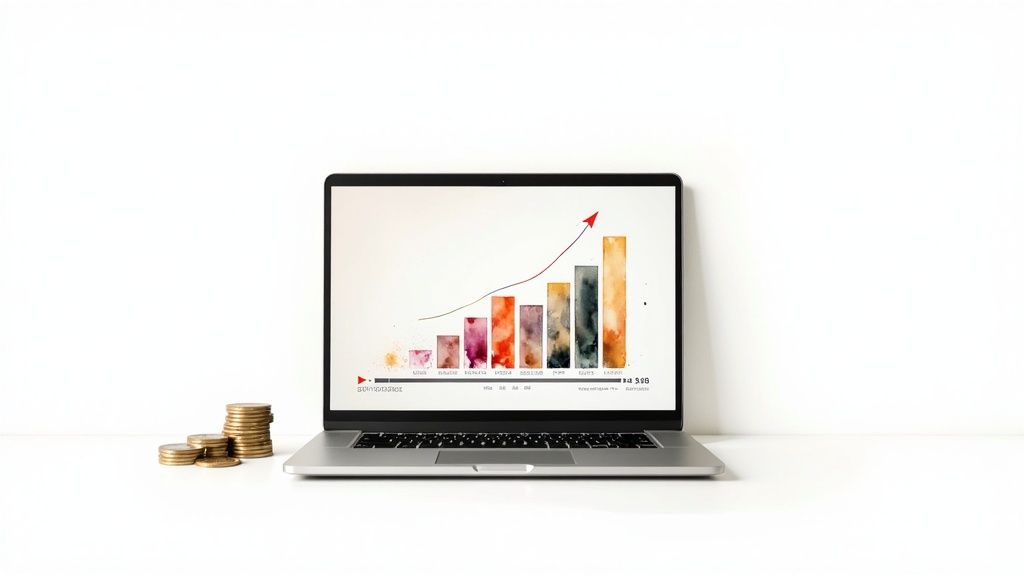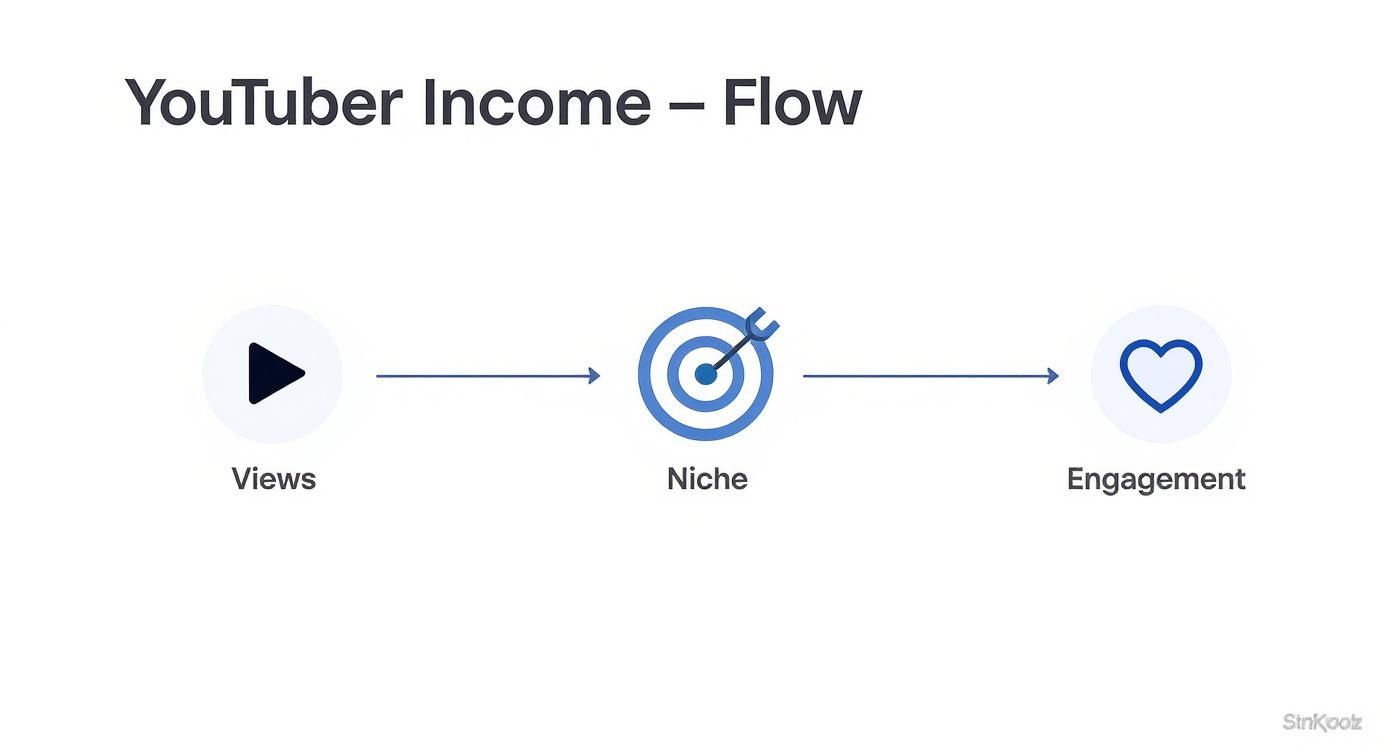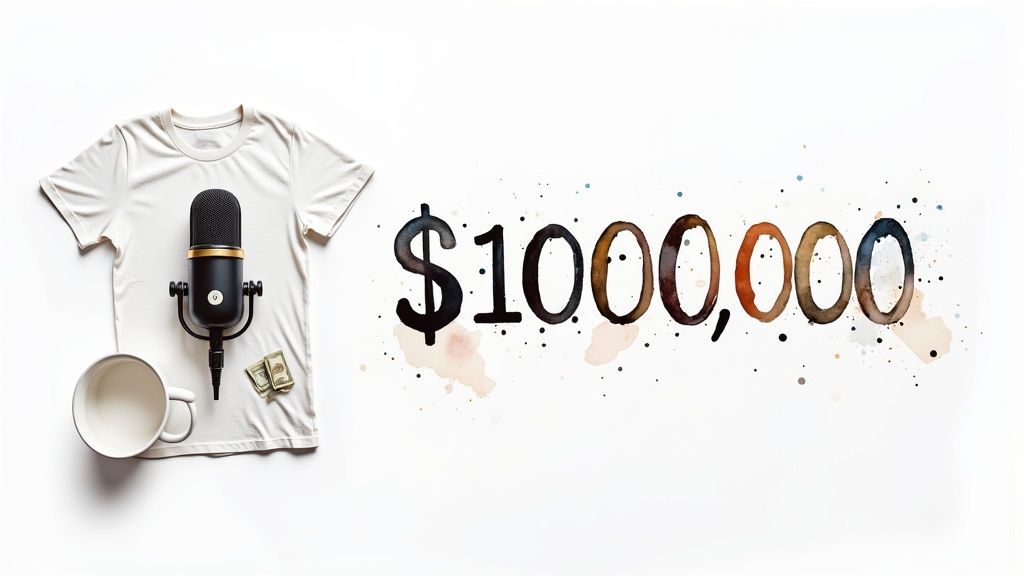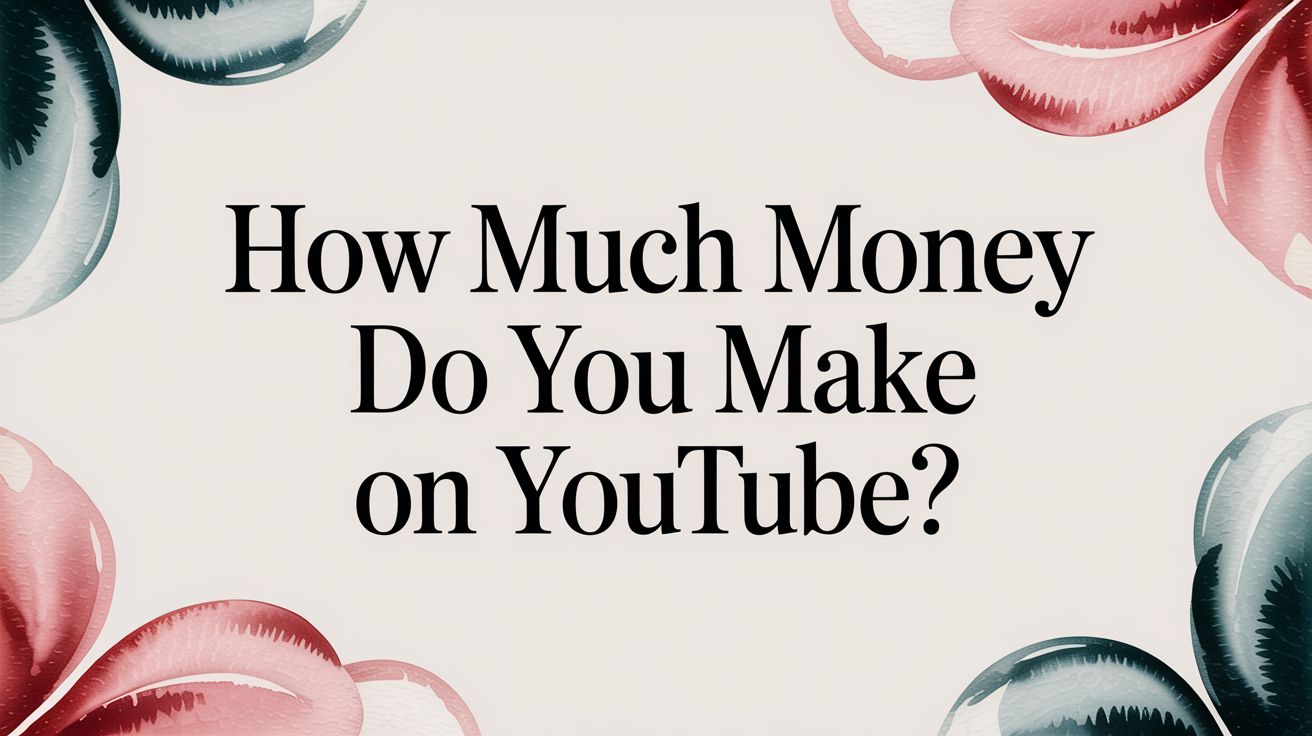You've probably heard that YouTubers make somewhere between $1 to $10 per 1,000 video views from ads. While that's a decent ballpark, the reality is far more complex. A video with one million views could make a creator $1,000 or it could make them $10,000—the difference comes down to who is watching, where they are, and what the video is about.
How Much YouTubers Actually Earn

Let's cut right to the chase: there’s no fixed salary for being a YouTuber. Earnings can swing wildly from month to month and depend far more on viewer engagement than on raw subscriber numbers. It’s less like a steady paycheck and more like running your own business, with all its ups and downs.
A creator's income is a cocktail of different revenue streams. It usually starts with ad money but can quickly grow to include brand deals, merchandise sales, and direct support from fans. To really get a handle on the money side of YouTube, you need to understand how all these pieces fit together.
The Big Factors That Drive Your Paycheck
So, what separates a channel earning pocket change from one that generates a full-time income? It's not just one thing, but a handful of key ingredients that determine a creator's financial success.
- Ad Revenue: This is the foundation for most creators. Money comes from the ads that play before, during, and after your videos.
- Your Niche & Audience: This is a huge one. A channel teaching people about investing will almost always earn more per view than a prank channel. Why? Because advertisers in the finance space are willing to pay a premium to reach that audience.
- Sponsorships & Brand Deals: This is where the real money often is. Brands will pay you directly to talk about their products, and these deals can easily eclipse your ad revenue.
- Fan Funding: YouTube has built-in tools like Channel Memberships, Super Chat, and Super Thanks that let your most loyal fans pay you directly. It's a powerful way to build a sustainable income.
The truth is, your subscriber count is mostly a vanity metric when it comes to earnings. Your income is directly tied to how many engaged viewers watch your monetized videos, not just how many people hit the subscribe button.
To get a better sense of the numbers, this article digs into how much YouTubers actually make by looking at real-world examples. If you want to run some numbers for your own channel, a good YouTube revenue estimator can help you project your potential earnings based on your views and niche.
Understanding Your Primary Paycheck: Ad Revenue
For most creators, the first dollar you earn on YouTube will probably come from ads. The best way to think about ad revenue is like a farmer’s harvest—its value is never fixed. It shifts with the season, what you’re "growing" (your niche), and what the market is willing to pay. This is the bedrock of how you get paid, but let's be honest, the mechanics can feel a bit murky at first.
At the center of it all are two acronyms you’ll get to know very well: CPM (Cost Per Mille) and RPM (Revenue Per Mille). They sound almost the same, but they tell two completely different parts of your earnings story.
- CPM (Cost Per Mille): This is the rate advertisers are paying YouTube for every 1,000 times their ad is shown on videos. Think of it as the "list price" for your channel's ad space.
- RPM (Revenue Per Mille): This is the number that actually hits your bank account. It’s your total revenue per 1,000 video views, and it's calculated after YouTube takes its 45% cut of the ad money. Your RPM is your real, take-home rate.
This infographic paints a clearer picture of how these pieces fit together to shape your income.

As you can see, your final payout is a blend of your views, your niche, and how engaged your audience is. It's never just about one metric.
Why Not All Views Are Equal
Getting a handle on the difference between CPM and RPM is so important because it reveals a fundamental truth of YouTube: not every view is worth the same amount of money. The real answer to "how much do you make on YouTube?" depends almost entirely on the powerful factors that drive your CPM.
It all comes down to who’s watching.
For example, a company selling expensive investment software will pay top dollar to run an ad on a finance channel. That same company couldn't care less about a channel that posts gaming pranks. As a result, the finance channel's CPM will be sky-high.
On top of that, where your viewers are located matters immensely. An advertiser will almost always pay more to reach a viewer in the United States or the United Kingdom than one in a country with less purchasing power. This geographic reality can cause huge swings in your income, even if your view count stays the same.
Key Takeaway: A channel with 100,000 views in a high-value niche like real estate can easily out-earn a channel with 500,000 views in a broad entertainment niche. When it comes to ad revenue, quality of viewership beats quantity every single time.
To really get a grip on your earning potential, you have to understand what makes these rates tick. For a much deeper dive, our guide explaining the CPM meaning for YouTube breaks down exactly what drives advertiser spending and, in turn, your paycheck.
The Financial Reality for Smaller Channels

Before the flashy sponsorships and big paydays, every creator starts in the same place: the long, quiet grind. For new and small channels, the financial reality is a very slow burn. You'll likely spend months—sometimes even years—creating content for a tiny audience before you see a single dollar.
This whole initial phase is a race to meet the entry requirements for the YouTube Partner Program (YPP). You can't earn anything from ads until you cross that finish line. The magic numbers are 1,000 subscribers and 4,000 hours of public watch time in the last 12 months.
From Zero to Your First Paycheck
That first monetized paycheck is a massive milestone, but don't expect it to be a big one. It's often just enough to buy a few coffees. After all that work, seeing just $10 or $20 trickle in can feel a bit anticlimactic, but it's powerful proof that the system actually works. Think of it as the starting line, not the destination.
From there, it’s all about a steady climb. One creator's two-year journey shows this growth perfectly. In their first year, while just trying to get monetized, the channel earned a grand total of $565. But in the second year, with the channel in the YPP and the audience growing, that income shot up to $44,061.
The toughest part of being a creator is putting in the work for months with nothing to show for it financially. Patience and consistency aren't just buzzwords; they're the tools you'll use to build the foundation for everything that comes later.
The Long Road to Consistent Income
This slow start isn’t unique to a few people; it's practically a universal experience. Most creators work for over a year before they can even think about applying for monetization. It's a period of creating, learning, and building a community without any immediate financial reward. Getting your expectations in check from the beginning is absolutely crucial.
Success isn't about getting lucky with one viral video. It's about consistently showing up until your watch time and subscriber count finally unlock the door to earning money. If you're looking for ways to speed this up, our guide on YouTube Partner Program eligibility has some practical strategies to help you meet those requirements faster. Building a steady income stream takes time, but it all starts with clearing that first major hurdle.
What a Million-Subscriber Channel Really Earns
Hitting one million subscribers isn't just a vanity milestone—it's the moment a YouTube channel transforms into a full-fledged business. The question "how much do you make on YouTube?" gets a much more interesting answer here. We're no longer talking about a simple ad revenue calculation; we're talking about a multi-layered income strategy where AdSense is just one piece of the puzzle.
For creators at this level, the game changes. They stop chasing views just for ad money and start building a powerful brand that attracts serious, high-value partnerships. While ad revenue provides a nice, steady foundation, brand sponsorships often steal the show and become the main engine driving their annual income.
It's a Business, Not Just a Channel
Once you prove you can hold the attention of a million people, your value to advertisers goes through the roof. You're not just a channel anymore; you’re a media platform. Brands will pay a premium to get their products in front of your loyal, engaged audience through sponsored videos and integrations.
This is where income streams really start to branch out:
- AdSense Revenue: It’s still a big deal. With millions of views coming in each month, ad revenue provides a substantial and reliable base income you can count on.
- Brand Sponsorships: This quickly becomes the biggest piece of the pie. A single sponsored video can easily earn more than an entire month of ad revenue. Seriously.
- Affiliate Marketing: With an audience of this size that trusts your recommendations, affiliate links can turn into a powerful source of passive income, bringing in thousands every month.
- Merchandise Sales: A loyal fanbase of a million people is primed to buy stuff. We're talking t-shirts, hoodies, mugs, or custom products that tie directly into your channel's niche.
Putting Some Real Numbers on It
So, what does this actually look like in dollars and cents? The earning potential is massive but also varies wildly.
From ads alone, a creator might earn between $5,000 to $7,000 per million views. But here's the kicker: a single sponsored video can fetch anywhere from $10,000 to $30,000. One report I saw broke down a channel of this size seeing its monthly income bounce between $14,600 and $54,600 from a mix of ads and brand deals. If you want to dive deeper, you can explore more detailed earnings breakdowns to see how these figures stack up.
At the million-subscriber level, you're not just a YouTuber anymore; you're the CEO of a media brand. Your focus moves from just making videos to building sustainable revenue systems, managing partnerships, and scaling your operation. It’s a transition from creator to entrepreneur.
This evolution is the real secret to generating a life-changing income. The most successful large channels don't just rely on YouTube to pay the bills. They use their YouTube audience as a springboard for a much bigger business, securing their financial future far beyond the ups and downs of ad rates and algorithms.
Proven Ways to Actually Increase Your YouTube Earnings
Knowing how YouTube calculates your paycheck is one thing, but making that number grow is the real goal. To really boost how much money you make, you can't just cross your fingers and hope for more views. You need a game plan.
Think of it as a two-part strategy. First, you squeeze more value out of the views you’re already getting. Second, you build entirely new ways to earn money that don't depend on YouTube’s ad system at all. Nail both of these, and you'll build a much stronger creator business that isn't at the mercy of shifting ad rates.
How to Get More from Your Ad Revenue
Not all videos are created equal in the eyes of advertisers. You can give your ad income a serious lift just by being smarter about the content you make and how you present it.
Go After High-RPM Niches: Like we talked about, topics like personal finance, technology reviews, and business tutorials attract advertisers with deeper pockets. Creating content in these spaces means you naturally earn a higher RPM, so every single view is worth more to you.
Make Longer Videos (8+ Minutes): This is a big one. Once a video crosses the eight-minute mark, you unlock the ability to place mid-roll ads. You can strategically insert these ads at natural pauses in your content, which massively increases the number of ads shown per video. It's a direct path to more revenue without needing a single extra viewer.
Boost Your Watch Time: The longer you can keep someone watching, the more YouTube's algorithm loves you—and so do advertisers. Focus on crafting videos with killer hooks in the first 30 seconds and a clear payoff that keeps people engaged right to the end.
Look Beyond AdSense for Real Growth
Relying solely on AdSense is risky. It's like trying to build a house on a single pillar. The most successful YouTubers know this; they build multiple streams of income to create a stable, predictable business. For a deeper look into this, understanding how to monetize content is a crucial step for any serious creator.
The smartest creators don't just depend on YouTube for a paycheck; they use YouTube as a platform to build a business. Ad revenue is the starting point, not the final destination.
Let’s look at a few of the most effective ways to diversify your earnings.
YouTube Revenue Stream Comparison
Thinking about which monetization methods to add can be overwhelming. Each one comes with its own potential rewards and level of effort. This table breaks down the most common options to help you decide which ones are the right fit for your channel right now.
| Revenue Stream | Earning Potential | Effort Level | Best For (Channel Type) |
|---|---|---|---|
| Ad Revenue | Moderate | Low | All monetized channels |
| Affiliate Marketing | High | Medium | Review, tutorial, and lifestyle channels |
| Memberships | Moderate | High | Channels with a loyal, engaged community |
| Super Chat/Stickers | Low to Moderate | Low | Channels that do frequent live streams |
| Merchandise | High | High | Channels with a strong brand identity |
| Digital Products | Very High | High | Educational and skill-based channels |
As you can see, there's a trade-off. Ad revenue is easy but has a ceiling. Digital products take a lot of work but offer the highest potential profit. The key is to pick one or two that align with your content and audience, and then build from there.
Here’s how to put these into practice:
Affiliate Marketing: This is often the best first step. You simply recommend products you already use and love, and you earn a commission when someone buys through your unique link. Just pop the links in your video descriptions. The best part? A single link in an old, popular video can continue to earn you passive income for years to come.
Digital Products or Merchandise: This is where you take full control. You can create and sell anything from ebooks and online courses to branded t-shirts and coffee mugs. It's more work upfront, but you control the product, the price, and you keep a much larger slice of the profit.
Fan Funding Features: Don't forget the tools YouTube gives you! Turn on Channel Memberships to offer exclusive perks like badges, emojis, and members-only videos. During live streams and premieres, remind your audience they can support you directly with Super Chat, Super Stickers, and Super Thanks.
Common Questions About YouTube Earnings
Alright, let's tackle some of the biggest questions that pop up when we talk about YouTube money. I get these all the time, so let's clear the air with some straight answers.
Think of this as the "ask me anything" part of the guide. We'll get into specific numbers and scenarios to make sure everything we've talked about really clicks.
How Many Views Do You Need to Make One Thousand Dollars
This is the million-dollar question, isn't it? Except, in this case, it's the thousand-dollar one. There’s no single answer because it all boils down to your channel's RPM (Revenue Per 1,000 Views).
Let's imagine two different creators. One has a channel with a lower RPM, say $2. To make $1,000, they'd need to rack up a whopping 500,000 views.
But now, picture a creator in a high-demand niche like finance or real estate. Their RPM could easily be $15 or even higher. For them, it would only take about 67,000 views to hit that same $1,000 goal. See the difference?
This is a perfect example of why focusing on your content niche and the quality of your audience is far more important than just chasing raw view counts.
Do YouTubers Get Paid for Shorts Views
Yes, you bet! If you're in the YouTube Partner Program, you absolutely earn money from the ads that run between videos in the Shorts Feed. It just works a little differently than it does for your regular, long-form videos.
Here's the quick version: All the ad money from Shorts gets put into one big pot every month. Then, YouTube divides that pot among all monetizing creators based on how many views their Shorts got.
While the RPM for Shorts is usually a lot lower than for standard videos, don't write them off. They are a fantastic way to get new eyeballs on your channel and can add a nice little boost to your monthly income.
Can I Make Money on YouTube Without Showing My Face
Definitely. You'd be surprised how many massive channels are completely "faceless," earning a great living without the creator ever stepping in front of the camera.
These channels are often brilliant at creating content that people will watch for years to come. Some popular ideas include:
- Animated stories and explainers
- Step-by-step software or app tutorials
- Relaxing music or ambient sound loops
- Documentary-style videos with a compelling voiceover
In the end, what matters is the quality of your content, your storytelling, and your editing skills—not whether your face is on screen. As long as you create something original and engaging, you can absolutely monetize it.
Ready to accelerate your watch time and reach monetization faster? 24/7 LiveStream keeps your channel live around the clock, boosting visibility and helping you hit your goals. Learn more and start your always-on stream today at https://247livestream.live.
